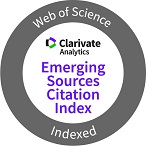Financial development and economic growth: panel evidence from BRICS
Keywords:
GrowthAbstract
Purpose. The purpose of this paper is to examine the relationship between financial development and economic growth for five major emerging economies: Brazil, Russia, India, China and South (BRICS) during 1993 to 2014 using banking sector and stock market development indicators.
Design/methodology/approach. To begin with, the study first examined some of the principal indicators of financial development and macroeconomic variables of the selected economies. Next, using generalized method of moment system estimation (SYS-GMM), the relationship between financial development and growth is investigated. The banking sector development indicators used in the study include size of the financial intermediaries, credit to deposit ratio (CDR) and domestic credit to private sector (CPS), whereas the stock market development indicators are value of shares traded and turnover ratio. Also, some macroeconomic control variables such as inflation, exports and the enrolment in secondary education were used.
Findings. The examination of the principal indicators of financial development and macroeconomic variables have shown considerable differences between the selected economies. Results from the dynamic one-step SYS-GMM estimates confirm that in presence of turnover ratio, all the selected banking development indicators such as size of financial intermediaries, CDR and CPS are positively significantly determining economic growth. Similarly, in presence of all the selected banking sector development indicators, value of shares traded is found to be positively significantly associated with economic growth. However, the same is not true when turnover ratio is regressed in presence of banking sector variables. Overall, the evidence suggests that banking sector development and stock market development indicators are complementary to each other in stimulating economic growth.
Practical implications. A positive association between financial development and growth indicates that the policymakers should take necessary measures toward simultaneous development of both banking sector as well as stock market for inducing growth.
Originality/value. The present paper attempts to examine the relationship between financial development and growth using both banking sector and stock market development indicators which has not been attempted before for BRICS. Also, most of the existing studies are found in case of developed economies. This paper tries to fill this void by studying five major emerging economies.
Downloads
References
Adusei, M. (2013), “Finance-growth nexus in Africa: a panel generalized method of moments (GMM) analysis”, Asian Economic and Financial Review, Vol. 3 No. 10, pp. 1314-1324.
Arellano, M. and Bond, S. (1991), “Some tests of specification for panel data: Monte Carlo evidence and an application to employment equations”, The Review of Economic Studies, Vol. 58 No. 2, pp. 277-297.
Beck, T. and Levine, R. (2004), “Stock markets, banks, and growth: panel evidence”, Journal of Banking and Finance, Vol. 28 No. 3, pp. 423-442.
Beck, T., Demirguc-Kunt, A. and Levine, R. (2000), “A new database on financial development and structure”, World Bank Economic Review, Vol. 14 No. 3, pp. 597-605.
Bencivenga, V.R. and Smith, B.D. (1993), “Some consequences of credit rationing in an endogenous growth model”, Journal of Economic Dynamics and Control, Vol. 17 Nos 1/2, pp. 97-122.
Bhanumurthy, N.R. and Singh, P. (2013), “Financial sector development and economic growth in Indian states”, International Journal of Economic Policy in Emerging Economies, Vol. 6 No. 1.
Blundell, R. and Bond, S. (1998), “Initial conditions and moment restrictions in dynamic panel data models”, Journal of Econometrics, Vol. 87 No. 1, pp. 115-143.
Buffie, E. (1984), “Financial repression, the new structuralists, and stabilization policy in semi-industrialized economies”, Journal of Development Economics, Vol. 14 No. 3, pp. 305-322.
Das, P.K. and Guha-Khasnobis, B. (2008), “Finance and growth an empirical assessment of the Indian economy”, in Guha-Khasnobis, B. and Mavrotas, G. (Eds), Financial Development, institutions, growth and Poverty Reduction, Palgrave Macmillan, New York, NY, pp. 120-140.
Demetriades, P.O. and Hussein, K.A. (1996), “Does financial development cause economic growth? Time series evidence from 16 countries”, Journal of Development Economics, Vol. 51 No. 2, pp. 387-411.
Diamond, D.W. (1984), “Financial intermediation and delegated monitoring”, The Review of Economic Studies, Vol. 51 No. 3, pp. 393-414.
Goldsmith, R.W. (1969), Financial Structure and Development, Yale University Press, New Haven, CT.
Greenwood, J. and Jovanovic, B. (1990), “Financial development, growth, and the distribution of income”, The Journal of Political Economy, Vol. 98 No. 5, Part 1, pp. 1076-1107.
Guha-Khasnobis, B. and Mavrotas, G. (2008), Financial Development, Institutions, Growth and Poverty Reduction, Palgrave Macmillan, New York, NY.
Hao, C. (2006), “Development of financial intermediation and economic growth: the chinese experience”, China Economic Review, Vol. 17 No. 4, pp. 347-362.
Hsiao, C. (1986), “Analysis of panel data”, No. 11, Econometric Society Monographs, Cambridge University Press.
Jung, W.S. (1986), “Financial development and economic growth”, Economic Development and Cultural Change, Vol. 34 No. 2, pp. 333-346.
King, R.G. and Levine, R. (1993a), “Finance and growth: schumpeter might be right”, The Quarterly Journal of Economics, Vol. 108 No. 3, pp. 717-737.
King, R.G. and Levine, R. (1993b), “Finance, entrepreneurship, and growth: theory and evidence”, Journal of Monetary Economics, Vol. 32 No. 3, pp. 513-542.
Leitao, N.C. (2010), “Financial development and economic growth: a panel data approach”, Theoretical and Applied Economics, Vol. 10 No. 551, pp. 15-24.
Levine, R. (1997), “Financial development and economic growth: views and agenda”, Journal of Economic Literature, Vol. 35, pp. 688-726.
Levine, R. and Zervos, S. (1998), “Stock markets, banks, and economic growth”, The American Economic Review, Vol. 88 No. 3, pp. 537-558.
Levine, R., Loayza, N. and Beck, T. (2000), “Financial intermediation and growth: causality and causes”, Journal of Monetary Economics, Vol. 46 No. 1, pp. 31-77.
Lucas, R.E. (1988), “On the mechanics of economic development”, Journal of Monetary Economics, Vol. 22 No. 1, pp. 3-42.
Luintel, K.B. and Khan, M. (1999), “A quantitative reassessment of the finance-growth nexus: evidence from a multivariate VAR”, Journal of Development Economics, Vol. 60 No. 2, pp. 381-405.
McKinnon, R.I. (1973), Money and Capital in Economic Development, Brookings Institution, Washington, DC.
Menyah, K., Nazlioglu, S. and Wolde-Rufael, Y. (2014), “Financial development, trade openness and economic growth in African countries: new insights from a panel causality approach”, Economic Modelling, Vol. 37, pp. 386-394.
Robinson, J. (1952), “The generalization of the general theory”, The Rate of Interest and Other Essays, Macmillan, London.
Rousseau, P.L. and Wachtel, P. (2000), “Equity markets and growth: cross-country evidence on timing and outcomes, 1980-1995”, Journal of Banking and Finance, Vol. 24 No. 12, pp. 1933-1957.
Saci, K., Giorgioni, G. and Holden, K. (2009), “Does financial development affect growth?”, Applied Economics, Vol. 41 No. 13, pp. 1701-1707.
Schumpeter, J.A. (1934), A Theory of Economic Development: An Inquiry into Profits, capital, credit, interest, and the Business Cycle, Harvard University Press, Cambridge, MA.
Shan, J. (2005), “Does financial development ‘lead’ economic growth? A vector autoregression appraisal”, Applied Economics, Vol. 37 No. 12, pp. 1353-1367.
Shaw, E.S. (1973), Financial Deepening in Economic Development, Oxford University Press, New York, NY.
Stiglitz, J.E. and Weiss, A. (1983), “Incentive effects of terminations: applications to the credit and labor markets”, The American Economic Review, Vol. 73 No. 5, pp. 912-927.
Wachtel, P. and Rousseau, P.L. (1995), “Financial intermediation and economic growth: a historical comparison of the United States, the United Kingdom, and Canada”, in Bordo, M.D. and Sylla, R. (Eds), Anglo-American Financial Systems: Institutions and Markets in the Twentieth Century, Irwin Professional Publishing, New York, NY, pp. 329-381.
Wijnberg, S.V. (1983), “Interest rate management in LDCs”, Journal of Monetary Economics, Vol. 12 No. 3, pp. 433-452.
Wolde-Rufael, Y. (2009), “Re-examining the financial development and economic growth nexus in Kenya”, Economic Modelling, Vol. 26 No. 6, pp. 1140-1146.
Downloads
Published
How to Cite
Issue
Section
License
Copyright (c) 2021 Journal of Economics, Finance and Administrative Science

This work is licensed under a Creative Commons Attribution 4.0 International License.











